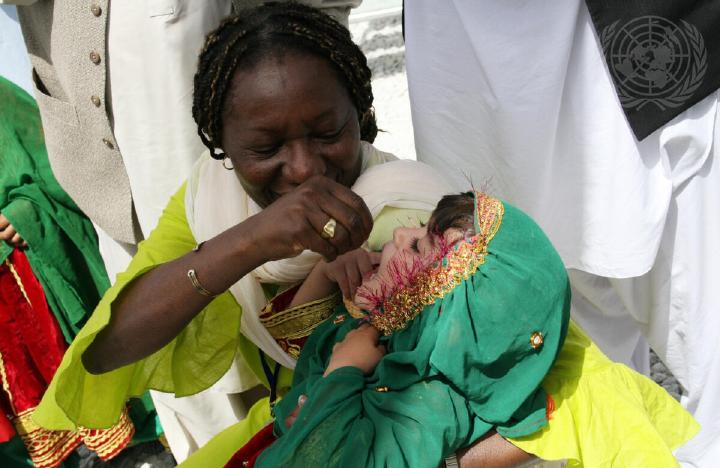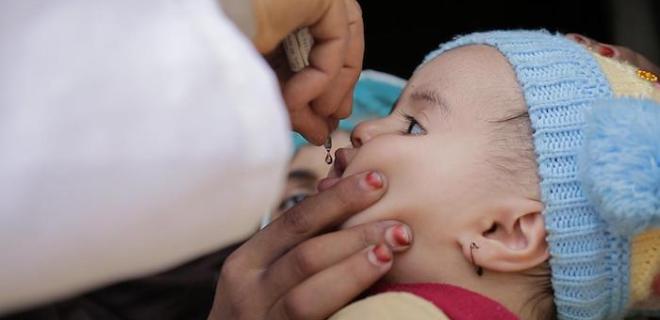
UN Photo/Khadivi
#VaccinesWork for All
The aim of World Immunization Week is to promote the use of vaccines to protect people of all ages against disease. The week takes place from 24-30 April. Every year, millions of lives are saved thanks to immunization and it is recognized widely as one of the most successful and cost effective health interventions. However, nearly 20 million children are still unvaccinated and under-vaccinated worldwide.
Immunization and COVID-19
In the lead up to this year’s World Immunization Week, countries across the globe are in the throes of responding to the COVID-19 pandemic. International development projects help countries protect critical immunization services during the COVID-19 pandemic, so that ground is not lost in the fight against vaccine-preventable diseases.
How Effective Are Vaccines? History of Immunization
Vaccines save at least 4 to 5 million lives every year. This remarkable success story is the result of massive immunization campaigns that have swept round the world in recent decades. Smallpox, which killed hundreds of millions, was eradicated in 1980, and polio cases have been reduced by more than 99% since 1988.
Dr. Kate O’Brien, Immunization Director at the World Health Organization, takes us on a historical tour from the development of the first modern vaccine in the late 18th Century, to the new vaccines that are combatting today’s COVID pandemic. The United Nations, and its partners in the COVAX facility, are ensuring that vaccines reach every low-income country in the world.
“Unacceptably, it’s often those who are most at risk – the poorest, the most marginalized, those touched by conflict or forced from their homes – who are persistently missed.”
Dr. Tedros Adhanom Ghebreyesus, Director-General of WHO

Photo: ©UNICEF/UN0143436/Alsamai
All World Bank Group operations in Yemen were suspended when the conflict worsened, but a partnership with the United Nations Children's Fund (UNICEF) and the World Health Organization (WHO) has allowed for the continuation of key activities of two Bank-funded health projects. The Health and Population Project has provided critical support for the national polio campaign that has managed to vaccinate 1.5 million Yemeni children despite the conflict.
The World Bank | Continuous Support of Childhood Immunizations
The World Bank Group (WBG) strongly supports childhood immunizations, as expanding access to vaccines is crucial for eliminating infectious diseases and achieving Universal Health Coverage. The WBG was one of the founding members of the Global Vaccine Alliance (Gavi) working to create access to new and underused vaccines for children living in the world’s poorest countries.
In countries affected by instability and conflict, the hardest to reach and most marginalized are the most vulnerable. In Yemen, the crisis has taken a heavy toll on the country's children. In support to protect the children, the WBG has channelled its funding through WHO and UNICEF to ensure the provision of continuous critical support for the delivery of essential health services – including national polio campaigns. The contribution has resulted in the vaccination of 1.5 million Yemeni children under five years old.
Yemen Health & Population Project ❭❱
Yemen: Improving Women & Children’s Health During the Conflict
About 50% of the health facilities in Yemen that provide lifesaving healthcare are non-functional due to the conflict. The World Bank and IDA are working with UNICEF & the World Health Organization on the Emergency Health and Nutrition Project, which supports mobile clinics that provide healthcare for children under 5 and pregnant women, supports public hospitals, and provides essential medications. The project also works to improve the water and sanitation system in Yemen.

Photo: ©Asian Development Bank
Over 580,000 people across the four countries will benefit from the project, which will improve overall immunization coverage rates and support greater efficiency of primary health services.
Asian Development Bank | Effective Coverage of New Vaccines
The proposed Supporting Effective Coverage of Health Technology in the Pacific Project by the Asian Development Bank forms part of the regional response to reduce the number of cervical cancer cases and other infectious diseases in children and women. The project proposes to use the introduction of new vaccines and early detection through communicable disease platforms to drive necessary improvements in the public health system in selected Pacific DMCs in line with the Asia Pacific Strategy for Emerging Diseases and Public Health Emergency.
“The project primarily aims to strengthen immunization systems by using the opportunity of introducing a new intervention (vaccines) into four health systems. Vaccines are recognized as one of the most cost-effective health investments, and a well-performing immunization program is an essential component of a functioning public health system.” – ADB Health Specialist for the Pacific Ms. Inez Mikkelsen-Lopez.
Coverage of Health Technology in the Pacific Project ❭❱
How the HPV vaccine works
This video uses infographics to show how the Human Papilloma Virus (HPV) may progress to cervical cancer, how the HPV vaccine works, and how it was tested for safety and efficacy before it was approved. The video is available in English and Russian. It was produced by the Danish Medicines Agency, which in partnership with WHO Regional Office for Europe have now made it available for use in other countries.

Sustainable Development Goals
Goal 3: Good Health and Well Being at all ages is essential to sustainable development.
International development projects foster better health systems, improve sanitation and hygiene, and increase access to health coverage.
UNDB facilitates global health and well being by supporting and encouraging investment in countries’ efforts to achieve universal health coverage, and provide quality and affordable health services to everyone.


